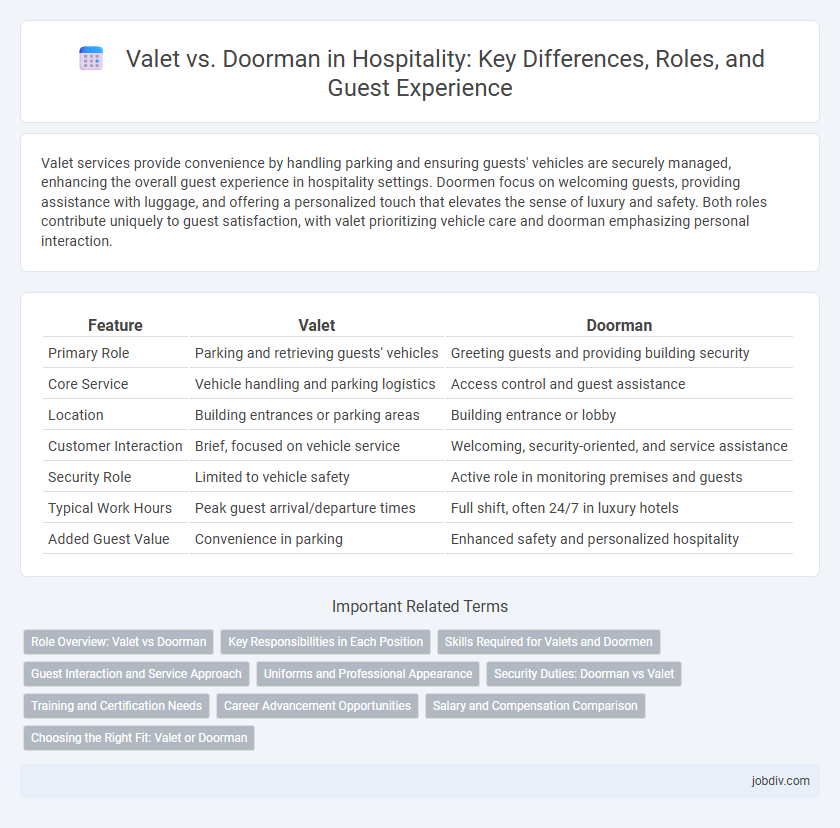Valet services provide convenience by handling parking and ensuring guests' vehicles are securely managed, enhancing the overall guest experience in hospitality settings. Doormen focus on welcoming guests, providing assistance with luggage, and offering a personalized touch that elevates the sense of luxury and safety. Both roles contribute uniquely to guest satisfaction, with valet prioritizing vehicle care and doorman emphasizing personal interaction.
Table of Comparison
| Feature | Valet | Doorman |
|---|---|---|
| Primary Role | Parking and retrieving guests' vehicles | Greeting guests and providing building security |
| Core Service | Vehicle handling and parking logistics | Access control and guest assistance |
| Location | Building entrances or parking areas | Building entrance or lobby |
| Customer Interaction | Brief, focused on vehicle service | Welcoming, security-oriented, and service assistance |
| Security Role | Limited to vehicle safety | Active role in monitoring premises and guests |
| Typical Work Hours | Peak guest arrival/departure times | Full shift, often 24/7 in luxury hotels |
| Added Guest Value | Convenience in parking | Enhanced safety and personalized hospitality |
Role Overview: Valet vs Doorman
Valets primarily handle vehicle parking and retrieval, ensuring guests experience seamless arrival and departure at hospitality venues. Doormen focus on greeting guests, managing entry access, and providing security, creating a welcoming atmosphere at hotel entrances. Both roles enhance customer service but specialize in distinct operational areas within the hospitality industry.
Key Responsibilities in Each Position
Valets primarily manage vehicle parking, ensuring secure and efficient car handling while providing prompt vehicle retrieval for guests. Doormen focus on guest reception, enhancing security by monitoring entry points, assisting with luggage, and offering personalized greetings to create a welcoming atmosphere. Both roles contribute to seamless guest experiences but differ in scope, with valets centered on transportation logistics and doormen emphasizing guest access and hospitality.
Skills Required for Valets and Doormen
Valets require exceptional driving skills, spatial awareness, and quick decision-making to safely park and retrieve vehicles in busy hotel environments. Doormen must possess strong customer service abilities, physical stamina, and effective communication skills to greet guests warmly and manage entry logistics smoothly. Both roles demand professionalism, attentiveness, and the capacity to handle high-pressure situations while maintaining a hospitable atmosphere.
Guest Interaction and Service Approach
Valets and doormen both enhance guest experience through personalized service, but their interaction styles differ significantly. Valets engage directly with guests to handle vehicle parking and retrieval, emphasizing efficiency and convenience, while doormen provide a warm welcome, assistance with doors, luggage, and directions, fostering a hospitable atmosphere. The service approach of valets prioritizes logistical support, whereas doormen focus on creating a lasting first impression through attentive and courteous guest interaction.
Uniforms and Professional Appearance
Valet uniforms typically include tailored suits or branded jackets with name tags, emphasizing ease of movement and professionalism to efficiently handle vehicle services. Doorman attire often features more formal, military-inspired uniforms with peaked caps and gloves, designed to convey authority and hospitality at entrances. Both uniforms prioritize cleanliness and sharp presentation to enhance guest experience and reinforce the luxury atmosphere of hospitality establishments.
Security Duties: Doorman vs Valet
Doormen enhance security by monitoring building entrances, verifying visitor identities, and managing access control, which deters unauthorized entry. Valets focus on vehicle security, parking logistics, and protecting guests' cars from theft or damage. Both roles provide complementary security functions essential for maintaining a safe hospitality environment.
Training and Certification Needs
Valet and doorman roles in hospitality require specialized training focused on customer service, safety protocols, and operational efficiency. Valets must be certified in vehicle handling, liability management, and emergency response to ensure guest vehicles are protected and managed correctly. Doormen undergo training in security procedures, guest interaction, and building access control, often requiring certification in safety and first aid to maintain a secure and welcoming environment.
Career Advancement Opportunities
Valet positions often provide foundational customer service skills and exposure to luxury clients, serving as a gateway to more specialized hospitality roles such as concierge or event coordination. Doorman roles offer enhanced opportunities for career growth in property management or security, leveraging expertise in guest relations and building access control. Both paths can lead to management positions, but doormen typically have broader prospects in operational supervision due to their direct involvement with building security and resident interactions.
Salary and Compensation Comparison
Valet attendants typically earn an average hourly wage of $12 to $15, with additional tips often increasing total compensation significantly, while doormen usually receive higher base salaries ranging from $30,000 to $40,000 annually due to broader responsibilities and union contracts. Valet roles may include gratuities that enhance earnings, contrasting with doormen whose compensation packages often incorporate benefits such as health insurance and paid time off. Salary variations also depend on location, employer prestige, and shift schedules within the hospitality industry.
Choosing the Right Fit: Valet or Doorman
Choosing between a valet and a doorman hinges on the specific needs of your hospitality establishment and guest expectations; valets excel in vehicle management and parking efficiency, while doormen provide enhanced security, personalized guest greetings, and assistance with luggage. Consider the location, volume of vehicular traffic, and desired level of guest interaction when making a decision to ensure seamless service and elevated guest satisfaction. Integrating either role strategically can significantly enhance the overall guest experience and operational flow.
Valet vs Doorman Infographic

 jobdiv.com
jobdiv.com